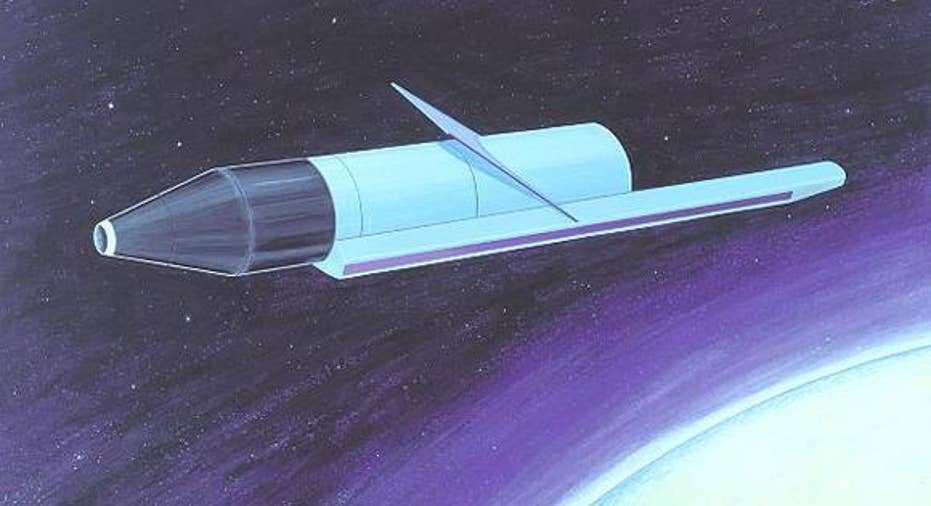1.5 Years to Mars? Russia Could Do It in 1.5 Months

As the head of Russian State Atomic Energy Corporation Rosatom, Sergey Kirienko is one of the first people you'd expect to play the cheerleader for nuclear power. What's unusual about Kirienko, though, is what he wants to use nuclear power for:
Powering spaceships.
Depiction of Russian RORSAT nuclear-powered satellite, c. 1970s. Image source: U.S. Defense Intelligence Agency.
In a recent addressto the Federation Council (Russia's Senate), former Prime Minister-turned-nuke-exec Kirienko proposed an ambitious project to cut the time needed to travel to Mars by 92%. For some years, Rosatom has been workingon the development of a megawatt-class "thermonuclear battery" for use in powering spaceships. Declared the former PM: "Installing a nuclear engine will allow [a spacecraft] tofly toMars ina month and a half and tocome back."
What's more, the spacecraft could make course changes en route if necessary, and even turn around and fly back to Earth, because with nuclear power, "the spacecraft would retain the ability tomaneuver."
Russia has significant experience in this field, having launched no fewer than 32 satellites and other spacecraft powered by nuclear fission between 1970 and 1988. Now they're ready to make the leap to applying that orbital experience to interplanetary travel.
How much would it cost?Experience notwithstanding, funding Rosatom's project could be an issue. Russian state news agency RTestimates it will cost $274 million over 15 years (the project, which began in 2010, is expected to be operational by 2025) to developnuclear fission-powered spaceflight. Then it would cost even more money to build the spaceship itself.
Kirienko's address to the Federation Council was apparently an attempt to shake loose more money for his project. But at the same time as Rosatom seeks funding for Mars, Russia's space agency, Roscosmos, is engaged in a $6 billion project to send cosmonauts to the Moon. Meanwhile, recent declines in the cost of oil have been putting pressure on all aspects of the Russian budget. Earlier this month, the government was forced to announce a 5% cutto the country's defense budget -- one sector that had previously been sacrosanct.
Will it happen?This puts Russia in the curious position of depending on a rise in the price of oil to help fund nuclear energy research. But even if oil prices remain low, and Russian government funding fails to materialize -- fear not. NASA is looking into options that could yield even speedier travel to Mars.
Last year, we learned that privately held space contractorAd Astrais developing a prototype nuclear engine for NASA. Like Rosatom's invention, the Variable Specific Impulse Magnetoplasma Rocket, or VASIMR, would use a nuclear reactor to heat and ionize propellant, then emit it through electromagnetic thrusters to propel a spaceship between planets. And although the technology sounds similar, Ad Astra believes its VASIMR engine will take a spaceship from Earth to Mars in just 39 days -- faster than Russia's rocket.
Nuclear research lab MNSWis looking into even farther-out options -- everything from nuclear fusion reactors to "plasmoid thrusters" and "electrodeless Lorentz force" (ELF) engines. And other NASA researchers continue to explore the ionic "EM Drive" concept, converting electricity directly to impulse power, potentially cutting travel time to Mars down to just 10 weeks.
Simultaneously, well-known NASA contractors Orbital ATK and Aerojet Rocketdyne are developing more tried-and-true technologies. Orbital ATK is working with NASA to develop two separate foldable solar panel products dubbed the ATK MegaFlex and DSS Mega-ROSA. In each case, the device will be used to convert sunlight to electrical power to propel a spaceship. At the same time, Aerojet Rocketdyne has a contract to develop an "Evolutionary Xenon Thruster-Commercial (NEXT-C) Gridded Ion Thruster System," which Aerojet says is three times as powerful as "current low-power NASA systems."
The long and the short of it appears to be this: Russia's dream of developing a nuclear engine to power spacecraft from Earth to Mars in 1.5 months may or may not pan out. Even if it fails, though, don't worry. NASA has plenty of other irons in the fire.
One way or another, we're going to get to Mars.
One advantage NASA's "VASIMR" project has over RORSAT: better cover art. Image source:NASA.
The article 1.5 Years to Mars? Russia Could Do It in 1.5 Months originally appeared on Fool.com.
Rich Smithdoes not own shares of, nor is he short, any company named above. You can find him onMotley Fool CAPS, publicly pontificating under the handleTMFDitty, where he's currently ranked No. 288 out of more than 75,000 rated members.The Motley Fool recommends Orbital ATK. Try any of our Foolish newsletter services free for 30 days. We Fools may not all hold the same opinions, but we all believe that considering a diverse range of insights makes us better investors. The Motley Fool has a disclosure policy.
Copyright 1995 - 2016 The Motley Fool, LLC. All rights reserved. The Motley Fool has a disclosure policy.